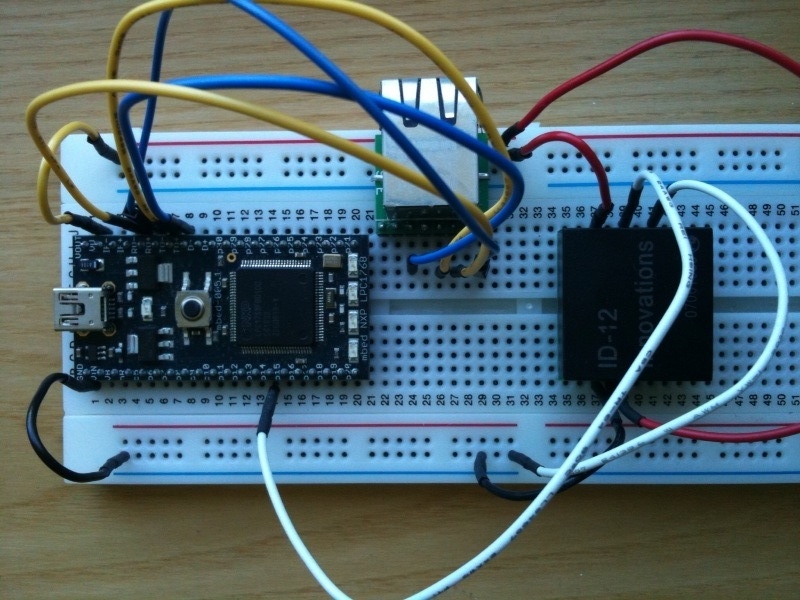Ch4_7 RFID 데이터를 트위터에 올리기
학습 내용
RFID 태크에서 인식된 신호를 트위터에 나타낼수있는 임베디드 클라우드 컴퓨팅( Embedded Cloud Computing: "Internet of Things")을 간단히 구현 해볼수 있습니다.
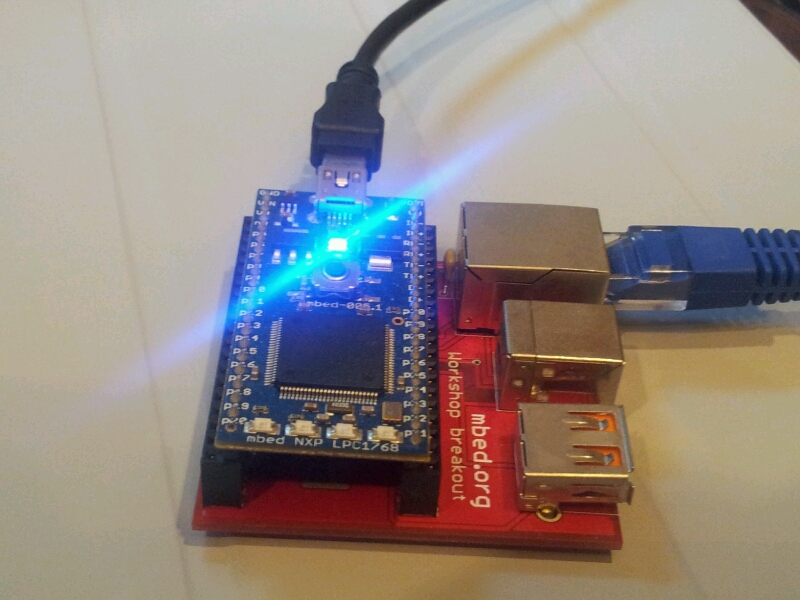
배선도 & 회로도
_하드웨어 구성요소_
필요한 하드웨어 구성 요소는:
- mbed 1개!
- ID-12 Innovations RFID reader 1개
- RJ-45 이더넷 소켓 1개
- A breadboard + some wires
_하드웨어 셋업_
하드웨어 셋업사진:

먼저 브레드보드에 mbed를 설치하고 접지를 (GND)핀과 브레드보드의 접지라인을 연결한 후 USB 파워핀(VU) 파워라인에 연결합니다.
RFID Reader
- 5V (pin 11) 과 RST (pin 2) 핀을 파워라인에 연결
- GND (pin 1) 과 FS (pin 7) 핀을 접지라인에 연결
- 마지막으로 D0 (pin 9) 을 mbed 의p14 (시리얼 입력 핀)에 연결
Ethernet Socket
- 소켓의 pin 3 을 mbed의 RD- pin에 연결
- 소켓의 pin 1 을 mbed의 RD+ pin에 연결
- 소켓의 pin 4 를 mbed의 TD- pin에 연결
- 소켓의 pin 6 을 mbed의 TD+ pin에 연결
Warning
소켓의 핀 출력은 단지 이 부품에서만 유효합니다.만약 다른 부품을 사용하면 핀 출력 포트를 재 확인해야 합니다.
배선 사진
마지막으로 네트워크 케이블을 소켓에 연결하면 mbed는 인터넷과 연결됩니다!
소프트웨어 설치
하드웨어를 작동하고 트위터에 연결하려면 다음의 라이브러리를 설치해야합니다:
_트위터 계정과 태그 설정_

Information
The basic authentication service for twitter is going down at the end of the week. To continue using that program, the code has been updated to use http://supertweet.net which acts as an API proxy. Simply visit the website to setup your twitter account for this API. See: http://www.supertweet.net/about/documentation
_Supertweet 계정 만들기_
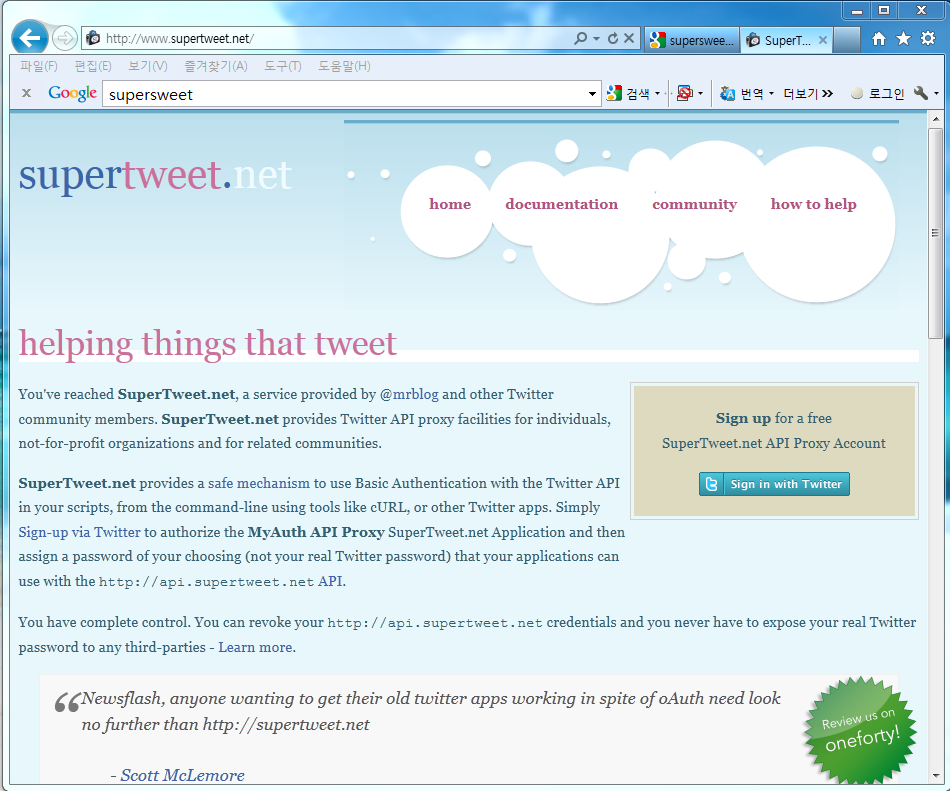
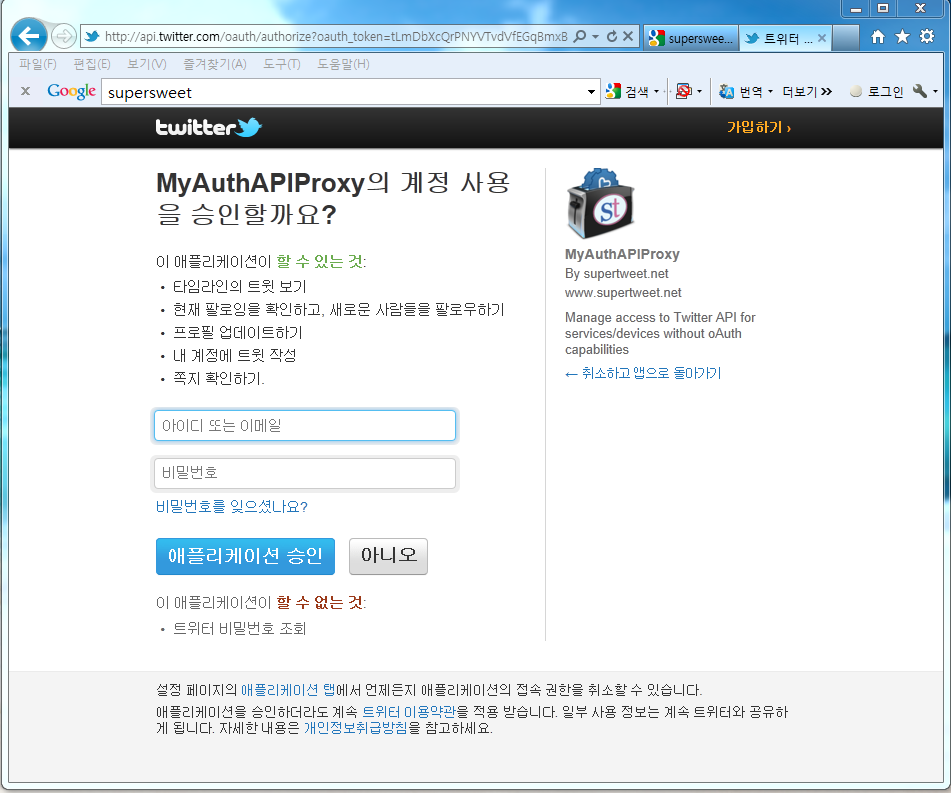

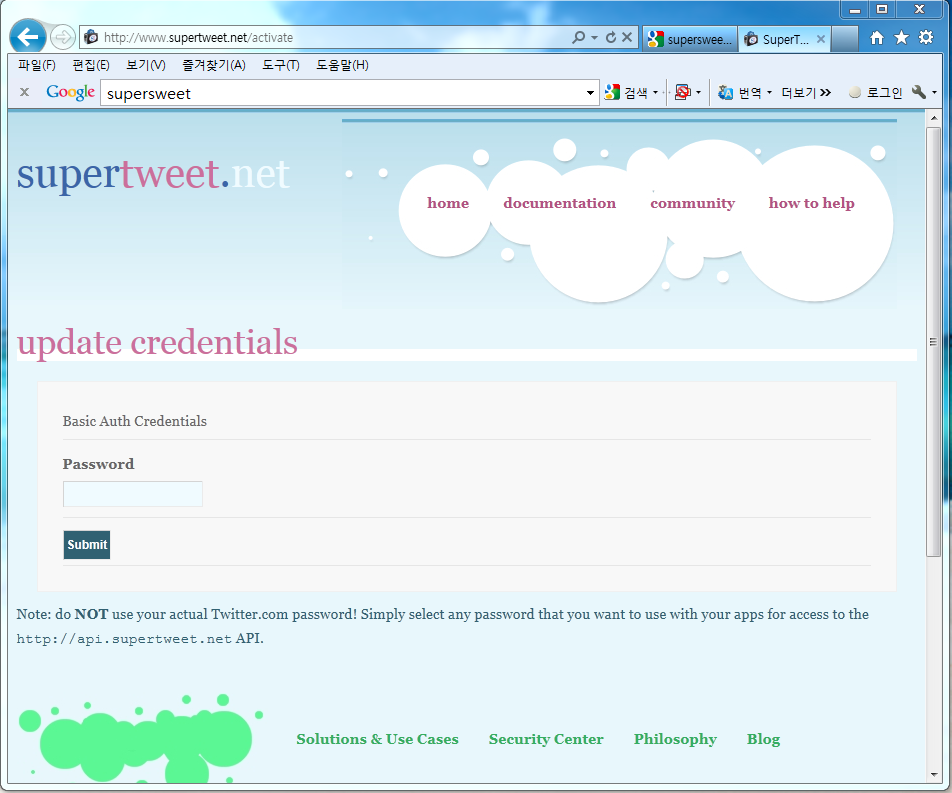
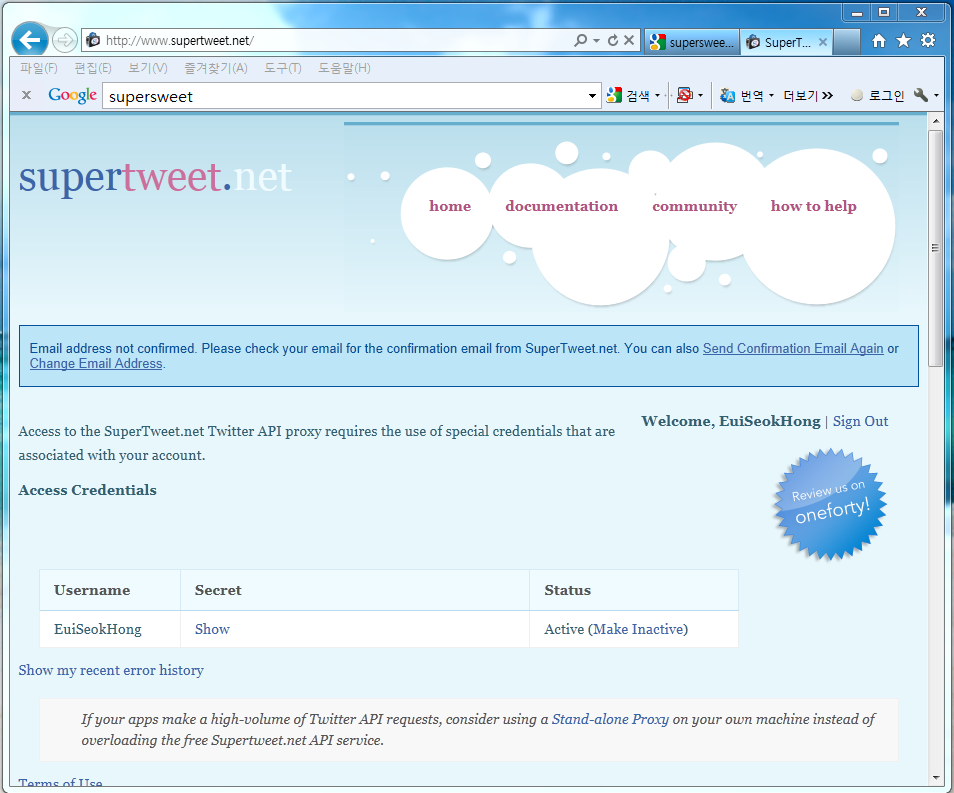

_Supertweet 테스트 코드_
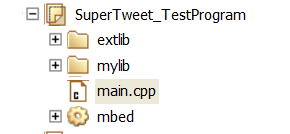
#include "mbed.h"
#include "EthernetNetIf.h"
#include "SuperTweetV1XML.h"
#define YOUR_ACCOUNT "EuiSeokHong"
#define YOUR_PASSWORD "110787"
extern "C" void mbed_reset();
EthernetNetIf net;
SuperTweetV1XML st(YOUR_ACCOUNT, YOUR_PASSWORD);
/**
* Callback function for postStatusesUpdate.
*
* @param buf A pointer to a buffer.
* @param siz A size of the buffer.
*/
void func(char *buf, size_t siz) {
#if 0
/*
* This is for checking a response.
*/
for (int i = 0; i < siz; i++) {
printf("%c", buf[i]);
}
#endif
}
/**
* Entry point.
*/
int main() {
char text[BUFSIZ];
int cnt = 0;
EthernetErr err = net.setup();
if (err) {
error("Network setup failed.\n");
}
while (1) {
snprintf(text, sizeof(text), "Hi! I'm mbed from ARM. Message number is %d", cnt++);
HTTPResult r = st.postStatusesUpdate(std::string(text), func);
printf("r=%d\n", (int)r);
/*
* Note:
* I don't know why sometime it get a error.
* I think it a bug in a mbed library.
*/
if (r != 0) {
printf("Resetting...\n");
mbed_reset();
}
wait(5);
}
}
_Tweet 테스트하기_
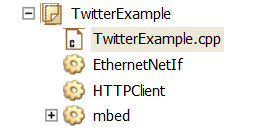
#include "EthernetNetIf.h"
#include "HTTPClient.h"
EthernetNetIf eth;
int main() {
printf("Init\n");
printf("\r\nSetting up...\r\n");
EthernetErr ethErr = eth.setup();
if(ethErr)
{
printf("Error %d in setup.\n", ethErr);
return -1;
}
printf("\r\nSetup OK\r\n");
HTTPClient twitter;
HTTPMap msg;
msg["status"] = "I am tweeting from my mbed!"; //A good example of Key/Value pair use with Web APIs
twitter.basicAuth("EuiSeokHong", "110787"); //We use basic authentication, replace with you account's parameters
//No need to retieve data sent back by the server
HTTPResult r = twitter.post("http://api.supertweet.net/1/statuses/update.xml", msg, NULL);
if( r == HTTP_OK )
{
printf("Tweet sent with success!\n");
}
else
{
printf("Problem during tweeting, return code %d\n", r);
}
return 0;
}


_TweetRFID 코딩_
프로그램 연결사이트:
실제로 프로그램을 작동하기 위해서는 다음의 셋업이 필요합니다.
- TWITTER_USER 와 TWITTER_PASSWORD 자기의 계정 파라메터를 입력한다.
- ids_list and names_list 테이블에 등록된 ID와 이름을 입력한다.
- IDS_COUNT에 등록된수로 업데이트 한다.
- (msg["status"])에 본인 나타내려는 문장을 입력한다...
코딩
main.cpp
// RFID Tweeter
#include "mbed.h"
#include "ID12RFID.h"
#include "EthernetNetIf.h"
#include "HTTPClient.h"
#define TWITTER_USER "donatiengarnier"
#define TWITTER_PASSWORD "myverysecurepassword"
#define IDS_COUNT 3
const int ids_list[IDS_COUNT] = {89481809, 89481810, 89481811};
const char* names_list[IDS_COUNT] = {"Donatien", "Simon", "Dan"};
EthernetNetIf ethernet;
HTTPClient twitter;
ID12RFID rfid(p14);
DigitalOut tag_present(LED1);
DigitalOut tweet_ok(LED4);
int main() {
ethernet.setup();
twitter.basicAuth(TWITTER_USER, TWITTER_PASSWORD);
while(true) {
int id = rfid.read();
tag_present = 1;
for(int i = 0; i < IDS_COUNT; i++) {
if (ids_list[i] == id) {
HTTPMap msg;
msg["status"] = names_list[i];
msg["status"] += " just arrived home!";
HTTPResult r = twitter.post("http://api.supertweet.net/1/statuses/update.xml", msg, NULL);
tweet_ok = !r;
}
}
tag_present = 0;
}
}
라이브러리
Import libraryEthernetNetIf
This library is deprecated.
Import library
| api_msg | This struct contains a function to execute in another thread context and a struct api_msg_msg that serves as an argument for this function |
| api_msg_msg | This struct includes everything that is necessary to execute a function for a netconn in another thread context (mainly used to process netconns in the tcpip_thread context to be thread safe) |
| dhcp_msg | Minimum set of fields of any DHCP message |
| dns_api_msg | As do_gethostbyname requires more arguments but doesn't require a netconn, it has its own struct (to avoid struct api_msg getting bigger than necessary) |
| DNSRequest | This is a simple DNS Request class |
| EthernetNetIf | Ethernet network interface |
| Host | Host information container |
| igmp_group | Igmp group structure - there is a list of groups for each interface these should really be linked from the interface, but if we keep them separate we will not affect the lwip original code too much |
| IpAddr | IP Address container |
| local_hostlist_entry | Struct used for local host-list |
| memp_malloc_helper | This structure is used to save the pool one element came from |
| mib_array_node | Derived node, points to a fixed size const array of sub-identifiers plus a 'child' pointer |
| mib_external_node | Derived node, has access functions for mib object in external memory or device using 'tree_level' and 'idx', with a range 0 |
| mib_list_rootnode | Derived node, points to a doubly linked list of sub-identifiers plus a 'child' pointer |
| mib_node | Node "base class" layout, the mandatory fields for a node |
| mib_ram_array_node | Derived node, points to a fixed size mem_malloced array of sub-identifiers plus a 'child' pointer |
| netconn | A netconn descriptor |
| NetService | Net Service base class |
| obj_def | Object definition returned by (get_object_def)() |
| pbuf_custom_ref | A custom pbuf that holds a reference to another pbuf, which is freed when this custom pbuf is freed |
| snmp_obj_id | Internal object identifier representation |
| snmp_resp_header_lengths | Output response message header length fields |
| snmp_trap_header_lengths | Output response message header length fields |
| TCPSocket | This is a simple TCP Socket class |
| UDPSocket | This is a simple UDP Socket class |
Import libraryHTTPClient_ToBeRemoved
HTTP Client library
Import library
| HTTPClient |
A simple HTTP Client The
HTTPClient
is composed of:
|
| HTTPMap | Map of key/value pairs Used to transmit POST data using the application/x-www-form-urlencoded encoding |
| HTTPText | A data endopint to store text |
| IHTTPDataIn | This is a simple interface for HTTP data storage (impl examples are Key/Value Pairs, File, etc...) |
| IHTTPDataOut | This is a simple interface for HTTP data storage (impl examples are Key/Value Pairs, File, etc...) |
Import library
| SuperTweet | SuperTweet API interface driver |
| SuperTweetV1XML | SuperTweet API interface driver |
학습 참고
Please log in to post comments.

